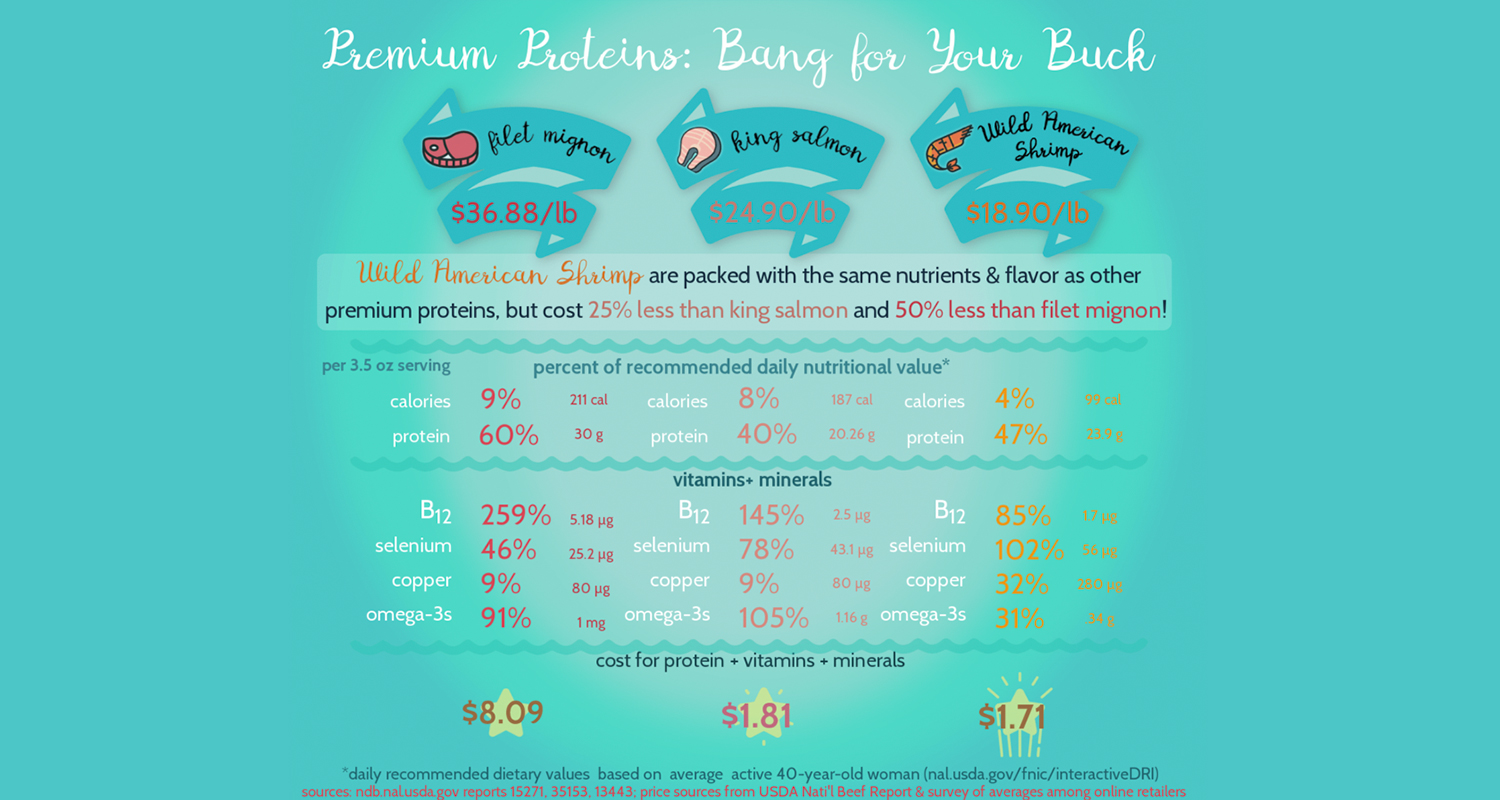The Premium Proteins: Shrimp, Steak, & Salmon
March 24, 2017

A few years ago when I was really broke, I took a freelance job writing a Paleo diet book. Note that I am not a dietitian. The bar for these assignments is pretty low. For the uninitiated, a Paleo diet is all about eating protein and veggies.
The bright side to that dark, dark time in my life is that the nutritional crash course comes in handy. Because I work with sustainable seafood, “what should I eat?” is the most common question I get. Also, when you’re writing terrible e-books to make rent, protein selection becomes a constant cost/benefit analysis: what’s affordable, healthy, and yummy? And when your friends take pity on you and treat you to dinner at a fancy restaurant and the menu is filled with meaty delights, what do you choose?
Here’s why I wouldn’t pick steak: If red meat didn’t have such a bad rep, I might spend $36 for a pound of it. And I get it; steak and filet are a treat, and it does have a lot of vitamin B12, selenium, and protein. Still, though, if I’m looking for max return on investment, filet wouldn’t be my pick.
Here’s why I wouldn’t choose chicken: no one orders chicken for their one nice meal. That’s like going to see your favorite musician in concert and listening to white noise on headphones the entire time.
Here’s why I’d order seafood (shocker, I know): Eating seafood twice a week is a thing you should do. It benefits your whole body because seafood has less fat and more good stuff than meats with feets.
Speaking of stuff in seafood, a quick note on mercury in fish: Multiple studies have found that the benefits of eating seafood far outweigh risks. In fact, eating too little seafood may increase risk for heart disease and slow cognitive development. Pregnant women and people with underlying health issues should take note of the new FDA guidelines regarding seafood consumption.
If there’s a nice wild-caught salmon on a menu, I always consider it. Salmon is a healthy, tasty choice and the only thing I don’t like about it is the price. A really lovely piece of king salmon might run $25+, but that splurge comes with lots of vitamins and protein, so I won’t dismiss it out of hand.
I’ll always consider shrimp as well, as long as I’m sure it’s reputable stuff, i.e. domestic and wild-caught. Shrimp are one of the lowest fat and calorie choices, high in protein, vitamins and minerals, and of least concern for mercury. Of all the chic meat options, wild-caught shrimp tend to be one of the most reasonably priced, which is always nice, even when you’re not scrapping. I’ll also avoid entrees where the shrimp (or any seafood) will be lost in mounds of pasta or heavy sauces. If I’m ordering shrimp, I want the flavor to shine through.
I’d like to take this opportunity to thank those friends who treated me to delicious food, downloaded my e-book, only briefly made fun of me, and sat through my price-to-nutrient valuation chats. You all are the best.
I’d also like to thank seafood and especially shrimp for making my decision (relatively) easy. You’re the savior of anyone who refuses to compromise, and I’ll keep singing your praises.

Suggested Articles
ASPA Fights Back Against Indian Shrimp Imports Made with Forced Labor
Port Arthur, TX (April 16, 2024) The American Shrimp Processors Association (ASPA) is taking aggressive action to combat imports of shrimp from India that were...
Read More April 2024American Shrimp Processors Association Launches Trade Petitions Addressing Unfair Dumping and Illegal Subsidies
Read additional information about the trade petitions, including public copies of ASPA filings. Today, the American Shrimp Processors Association (ASPA) filed trade petitions seeking antidumping...
Read More October 2023Bipartisan Legislation Introduced to Ensure the Availability of Healthy and Safe American Shrimp
WASHINGTON, DC – U.S. Representatives Garret Graves (Louisiana) and Kathy Castor (Florida) introduced legislation to stop unsafe, illegally-produced shrimp from reaching consumers. Much of the shrimp...
Read More August 2023

